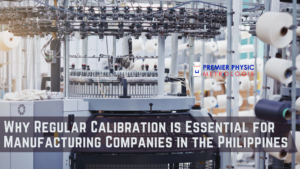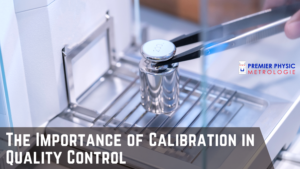In the highly competitive landscape of modern manufacturing, quality control is paramount. Consumers demand products that meet stringent specifications, and manufacturers strive to minimize defects and maintain consistency. At the heart of effective quality control lies calibration, a process that ensures the accuracy and reliability of measuring instruments. Without proper calibration, even the most advanced manufacturing processes can produce flawed results, leading to costly rework, customer dissatisfaction, and damage to brand reputation. This comprehensive guide delves into the crucial role of calibration in enhancing quality control within manufacturing, exploring its impact on various aspects of production and highlighting its significance for achieving excellence.
The Foundation of Accurate Measurements:
Calibration is the process of comparing the readings of a measuring instrument to a known standard or reference value. It involves adjusting the instrument to bring its readings into closer agreement with the standard, thereby minimizing measurement errors. In manufacturing, accurate measurements are essential for ensuring that products meet design specifications and quality standards. Without calibrated instruments, manufacturers cannot guarantee the precision and consistency of their products.
Impact of Calibration on Manufacturing Processes:
Calibration plays a vital role in various manufacturing processes, including:
- Dimensional Measurement: Ensuring that product dimensions meet design tolerances.
- Weight Measurement: Guaranteeing accurate weight measurements for raw materials, finished products, and packaging.
- Temperature Measurement: Maintaining precise temperature control in processes like heat treatment, molding, and welding.
- Pressure Measurement: Ensuring accurate pressure readings in hydraulic and pneumatic systems.
- Electrical Measurement: Verifying the accuracy of electrical parameters in electronic components and systems.
Benefits of Calibration in Quality Control:
Implementing a robust calibration program offers numerous benefits for manufacturers:
- Reduced Defects and Rework: Accurate measurements minimize the risk of producing defective products, reducing the need for costly rework and scrap.
- Improved Product Consistency: Calibration ensures that products are manufactured to consistent standards, enhancing customer satisfaction and brand loyalty.
- Enhanced Process Control: Calibrated instruments provide reliable data for process monitoring and control, allowing manufacturers to optimize production processes.
- Increased Efficiency: Accurate measurements reduce the need for unnecessary adjustments and inspections, improving production efficiency.
- Reduced Costs: Minimizing defects and rework leads to significant cost savings.
- Compliance with Standards: Calibration helps manufacturers comply with industry standards and regulations, such as ISO 9001 and ISO/IEC 17025.
- Enhanced Customer Trust: Demonstrating a commitment to quality through calibration builds customer trust and confidence.
- Improved Product Safety: In industries like healthcare and aerospace, accurate measurements are critical for ensuring product safety.
Key Elements of a Calibration Program:
A successful calibration program should include the following key elements:
- Identification of Critical Instruments: Identify the measuring instruments that are critical to product quality and process control.
- Establishment of Calibration Intervals: Determine the appropriate calibration intervals for each instrument based on factors like usage, stability, and risk assessment.
- Selection of Calibration Standards: Choose calibration standards that are traceable to national or international standards.
- Implementation of Calibration Procedures: Develop and document detailed calibration procedures for each instrument.
- Maintenance of Calibration Records: Keep accurate records of all calibration activities, including calibration certificates and reports.
- Training of Personnel: Ensure that personnel involved in calibration are properly trained and competent.
- Regular Review and Improvement: Regularly review and improve the calibration program to ensure its effectiveness.
Traceability and Measurement Uncertainty:
Traceability is a crucial aspect of calibration. It ensures that measurements are linked to a recognized standard, providing confidence in their accuracy and reliability. Measurement uncertainty is another important consideration. It represents the range of values within which the true value of a measurement is likely to lie. Calibration reports should include an estimate of measurement uncertainty to provide a realistic assessment of the measurement’s accuracy.
Calibration and Industry Standards:
Several industry standards provide guidelines for calibration practices:
- ISO 9001: This standard emphasizes the importance of calibration for quality management systems.
- ISO/IEC 17025: This standard specifies the general requirements for the competence of testing and calibration laboratories.
- ANSI/NCSL Z540-1: This standard provides requirements for calibration laboratories and measuring and test equipment.
- ISO 10012: Measurement management systems — Requirements for measurement processes and measuring equipment.
The Role of Automation in Calibration:
Automation is increasingly being used in calibration processes to improve efficiency and accuracy. Automated calibration systems can perform calibrations quickly and consistently, reducing the risk of human error. They can also generate detailed calibration reports and track calibration data.
Calibration and Predictive Maintenance:
Calibration data can be used for predictive maintenance, allowing manufacturers to identify potential equipment failures before they occur. By monitoring calibration trends, manufacturers can detect drift or degradation in instrument performance and take corrective action.
Calibration and Continuous Improvement:
Calibration is an integral part of continuous improvement efforts. By monitoring calibration data and analyzing trends, manufacturers can identify areas for improvement in their processes and equipment.
Overcoming Challenges in Calibration:
Manufacturers may face several challenges in implementing a calibration program, including:
- Cost of Calibration: Calibration can be expensive, especially for complex instruments.
- Downtime for Calibration: Calibrating instruments can require downtime, which can impact production.
- Lack of Skilled Personnel: Calibration requires specialized knowledge and skills.
To overcome these challenges, manufacturers can:
- Prioritize Calibration: Focus on calibrating the instruments that are critical to product quality.
- Optimize Calibration Intervals: Establish realistic calibration intervals based on risk assessment.
- Utilize External Calibration Services: Consider using external calibration services for specialized instruments.
- Invest in Training: Provide training to personnel to develop their calibration skills.
Conclusion:
Calibration is an indispensable component of effective quality control in manufacturing. By ensuring the accuracy and reliability of measuring instruments, calibration minimizes defects, improves product consistency, and enhances overall product quality. Implementing a robust calibration program not only helps manufacturers comply with industry standards and regulations but also builds customer trust and confidence. In today’s competitive market, manufacturers that prioritize calibration gain a significant advantage, ensuring the production of high-quality products that meet customer expectations and drive business success. By investing in a comprehensive calibration program, manufacturers are investing in the very foundation of their product’s integrity and their customer’s satisfaction.




